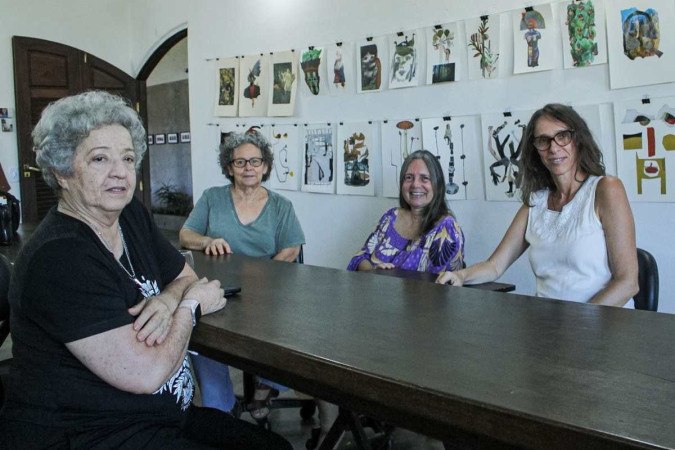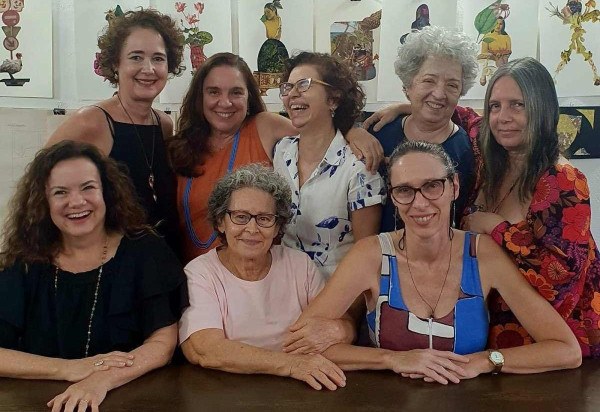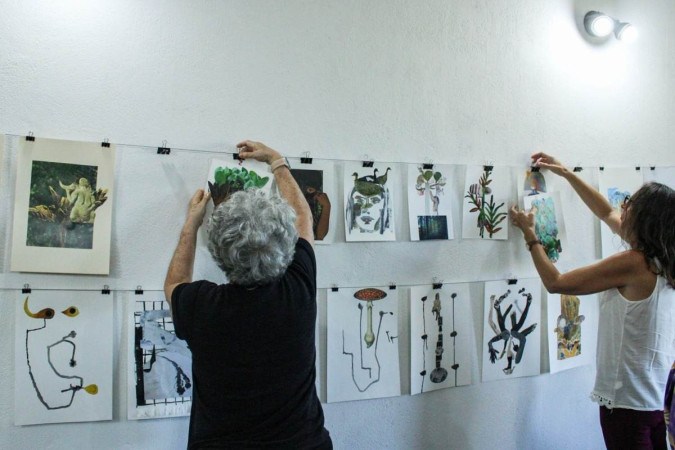Published on 02/25/2024 at 06:00 / Updated on 02/25/2024 at 06:00

Marcia Gramko, née Clara de Lima, Lilia Lovigo, and Patricia Rodriguez at Villarejo Studio 21, where the group meets monthly – (Source: Kayo Magalhäes/CB/DA Press)
Int(22)
Eight friends, former students of the University of Brasilia, come together 30 years after graduating from college to make collages. What is new in this case is that the professionals are not trained in the arts, but in anthropology. The Antropo(i)lógicas collective was born with the aim of expressing ideas and reflections about the world in an artistic way
Professionals work with the language of collage, a composition that uses visual materials with different textures that form new images. The project has been around since 2022 and can be seen at Vilarejo 21, an independent space for arts, creativity and culture located in Paranoa, where the group's meetings are held.
The collages created by the Iló Collective, as it has become known, are generally made based on themes, which eventually end up becoming series, such as totems, hybrid beings, characters, and tree people. Everything is done intuitively, according to the symbolic, formal and personal repertoire of each participant. For inspiration, the friends bring references from Surrealism and Dada, fieldwork carried out in anthropology and other collage collections and artists they admire. Experiments are carried out with gouache, watercolors and, mainly, clippings from magazines and books, including photographs contained in these materials.
For Lilia Lovigo, the group's coordinator, art is rooted in anthropology and can broaden discussions in the region. “Art is the possibility of presenting social criticism, but it is also the possibility of dreaming and transcendence, of showing surrealism and reality,” he explains. The idea for the group came from a project Lilia previously carried out at Sara Kubitschek Hospital. Collage has been used to stimulate creativity in rehabilitation patients.
For Lilia Lovigo, the group's coordinator, collage is a way to critique, reflect and imagine old and new worlds. “To better understand this relationship between anthropology and collage, we need to go back to the history of anthropology itself, which emerged in the European context after World War I, when Dada and Surrealism also emerged. In these movements, collage emerged as a response to the meaninglessness of a world at war He explains that the artistic avant-garde and anthropology were criticizing an ideology that excluded the other, the different, as part of the same humanity.
She highlights that collage is a democratic artistic language, and does not require artistic skill or special materials. He adds: “In the face of collapsing worlds, wars, and epidemics, art achieves another meaning, a refuge and a response against barbarism.”
(Photo: Personal Archive)
Marcia Maria Gramkow, one of the group members, believes that collage is an art that speaks to specific areas of science. “It is a way of representation, a form of language, linked to disciplines such as visual anthropology, where photographic materials, records, and ways of conveying action and thought are produced,” he explains.
an exercise
When creating the group, not all participants were familiar with this technique, so it took time to study and prepare. The training, which takes place on an ongoing basis, is promoted during the group's monthly meetings.
For Niy Clara de Lima, a researcher working in the field of cultural, tangible and intangible heritage, the process of learning the art of collage has been difficult, but rewarding. “My work has always been more focused on academic writing and the theoretical dimension of anthropology. So, the collage experience showed me ways of understanding culture in, let's say, a more assimilation dimension. In other words, what I learned and learned from an anthropological perspective proved, in collage, to be a poetic experience.” increasingly.
Ni believes there is still a long way to go for the group to specialize in this field and see itself as an artistic group, in fact, but for her, the greatest importance of the experience lies in expressing itself artistically. “I have not seen the world without anthropology for a long time, but I want to go beyond that reading to be able to understand my own subconscious in a deeper way, and also to understand how culture reaches this level,” he explains.
disclosure
(Photo: Caio Magalhaes/CB/DA Press)
Antropo(i)lógicas collections are published on Instagram @coletivoilo, which contain an archive of completed works and texts that seek to place images in their conceptual context. Visibility through social media allowed them to connect with other groups, such as Sociedade Brasileira de Collagem and Rede Collage Brasil.
“On Instagram, we know a whole community of artists who we can talk to and exchange experiences,” says Lilia. “We want to learn about the production process that other collage artists do, with different ways of creating,” Marcia emphasizes.
Adriana Marez says the group started meeting in Lilia's studio without any pretensions, but now they're watching the work take shape. “We have received invitations to participate in open talks and meetings with other groups and are looking for notices to create an exhibition and book collecting our work,” he reveals.
However, for the project creator, the group makes a difference compared to others with whom they have exchanged experiences: it consists only of people with the same training. “Most groups are heterogeneous, with people from different backgrounds, so our group has this uniqueness of only having anthropologists as part of it, which results in a common language for this field of knowledge,” he says.
Beyond the galleries
The collages produced by the group expanded to include the participants’ workplaces, as therapeutic materials and materials in universities. Adriana Marez, in addition to her training as an anthropologist and actress, is a holistic therapist and facilitator of self-development groups. Since the pandemic, he has been in contact with collage through the SoulCollage method, and was fascinated: “This burst of creativity has changed my outlook, and brought about amazing changes in my professional work, which now relies on collage as a playful and intuitive element that, by stimulating imagination and creativity, brings a new perspective to the subject.” In their work on themselves and their relationship with the world.
She stated that collage and anthropology, that is, art and science, are areas that can be worked on in an interdisciplinary manner. “The greatest challenge is confronting the reactionary social forces that insist on demonizing art and science, with a discourse that wants to separate inseparable aspects of the human soul, such as poetry, intuition, curiosity, taste for knowledge, and pleasure. “Being part of the group,” he explains.
Fellow colleague Rita de Almeida Castro also brought the art of collage closer to theater through the topic “Performative Practices in Dialogue with Eastern Approaches: Perception, Senses and Imagination,” which she teaches in the Performing Arts course at the University of Bahrain, where she has worked for 29 years. The specialty is new, introduced since 2022, and works with collage from perspective HaikuJapanese poems. Students need to create collages that take into account abstract elements related to their dreams.
Rita has worked as an artist for decades, working on performing arts themes in her undergraduate, Masters and PhD research. Even with all that going on, she says that engaging with collage has been revelatory: “You start to delve deeper into the collage, and you see that there are layers in the textures, and it expands your view of the world. And that for an artist is very rich.”
In addition to the personal experience, on the other side of the screen, the group wants to promote different reflections in the imagination of those who see the collages “and who knows, the desire to also venture into this experience, which touches very closely on what cannot be measured,” says Adriana. Separation, intuition, and transience.”
*Intern under the supervision of Priscilla Crespi

“Wannabe internet buff. Future teen idol. Hardcore zombie guru. Gamer. Avid creator. Entrepreneur. Bacon ninja.”


